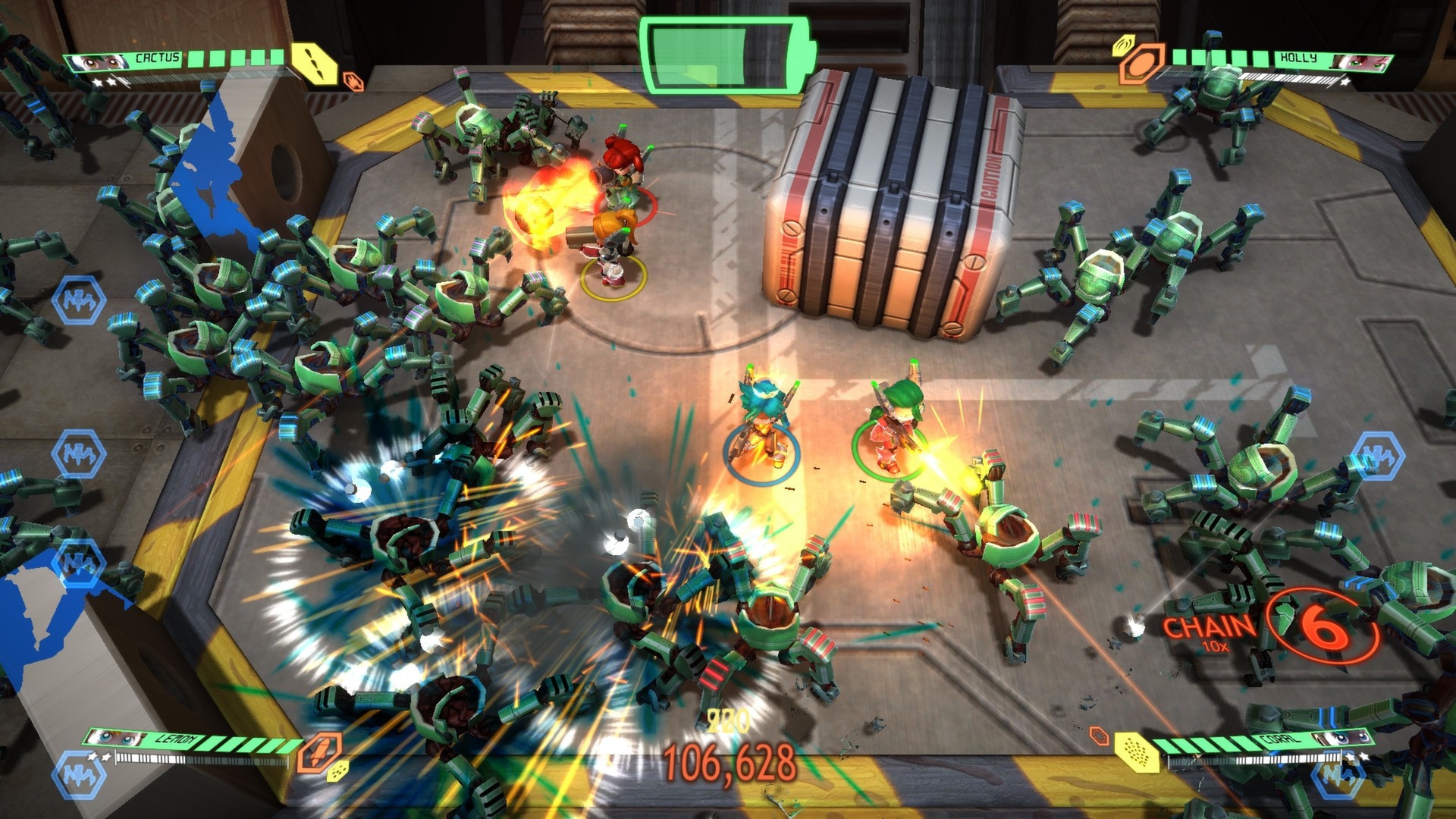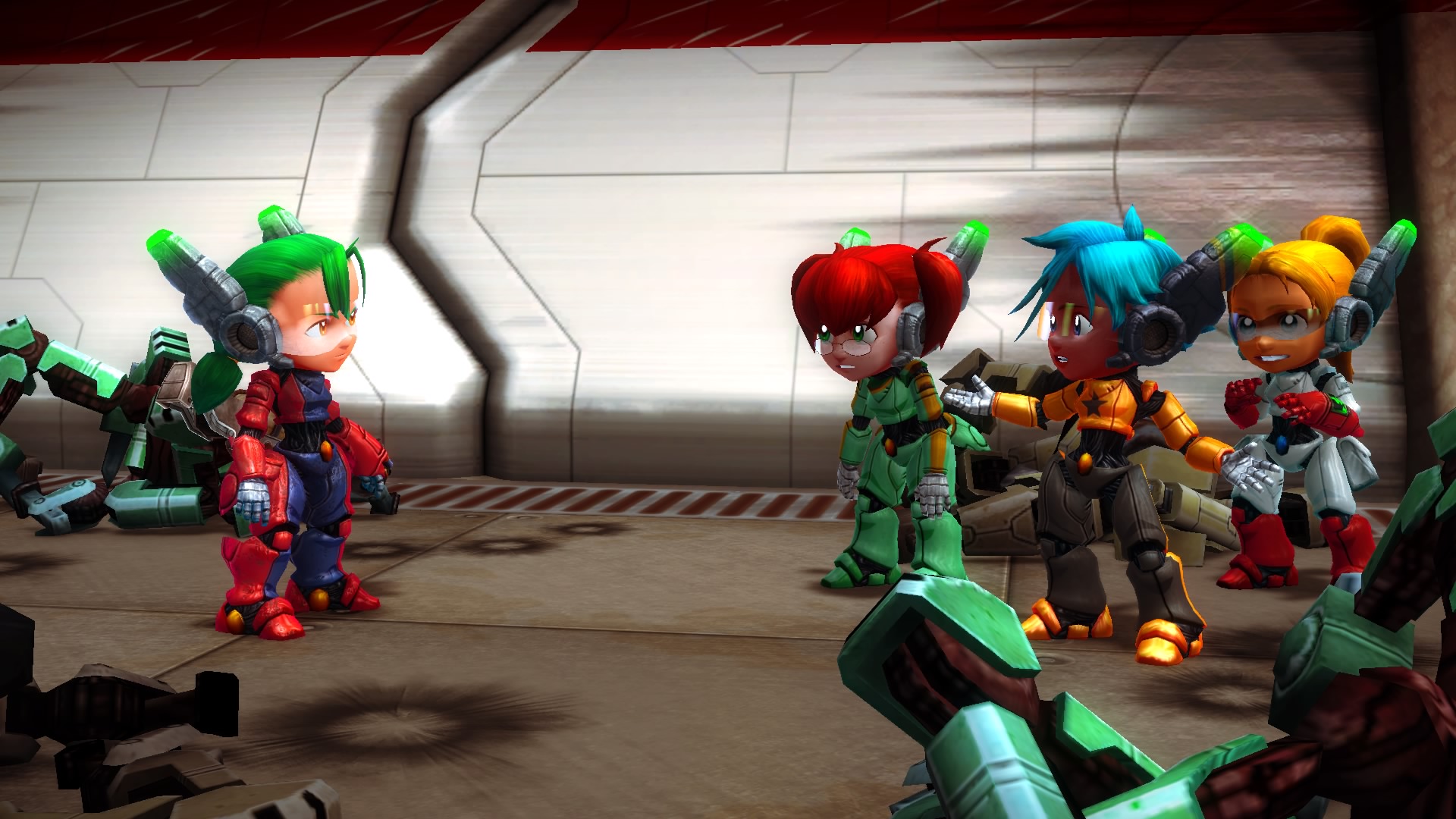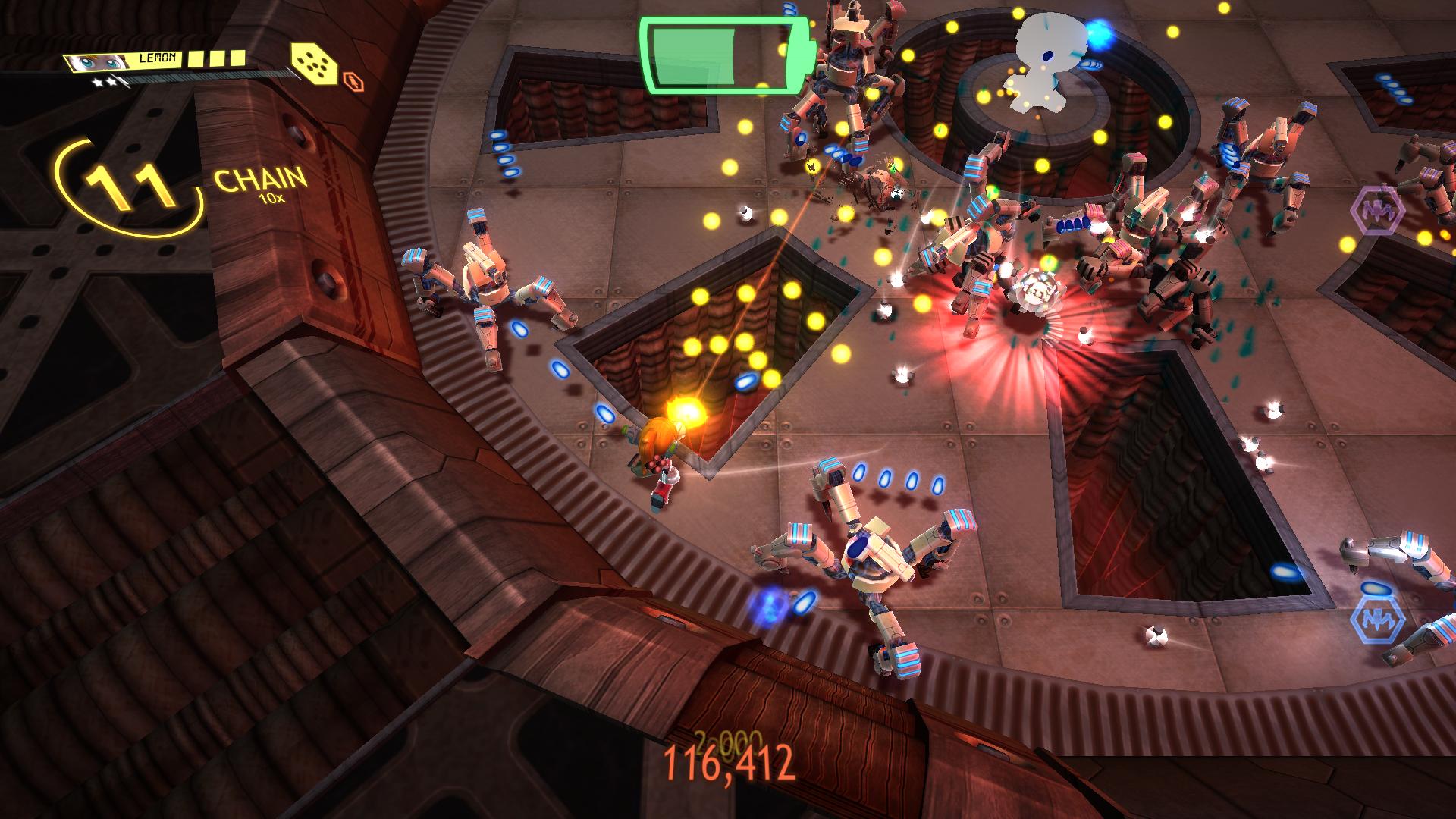Assault Android Cactus Review – Is it Worth Playing Now?

Developed by Witch Beam, Assault Android Cactus is a twin-stick shooter set in a cartoon sci-fi setting. You take control of one of a selection of androids fighting an mutinous uprising on a ship, blasting through hordes of enemies in a series of stages from a top-down perspective.
I’ve always had an affinity for twin stick shooters, ever since picking up and falling in love with the original Geometry Wars. When Assault Android Cactus became available as one of Xbox Live Gold’s titles, I was excited to pick it up and give it a go.
Is it any good? Here’s the Good, the Mixed and the Bad:
Good
Fluid controls: Probably the most important thing that a twin-stick shooter has to get right is the feel of the controls. The left stick moving your character and right stick aiming need to be tuned in such a way that both actions synchronise, and AAC fortunately succeeds in this key area.
The characters glide around the arena at a satisfying speed (which doubles temporarily via power-up) and firing the various weapons unique to each character feels responsive and reliable.

Gameplay depth: As well as feeling responsive, a twin-stick shooter lives and dies by the depth of its gameplay. It needs to straddle the line between being easy to pick up, and difficult and satisfying to master. Thankfully, AAC achieves this balance for the most part, with the controls and mechanics become second nature after the first few tries. Holding RT to shoot as well as aiming the direction with the right stick takes a little getting used to, and the requirement for battery-pack top-ups adds a little bit of a game-management element that takes some acclimatising, but after ten minutes you’ll find yourself in a satisfying flow of reflex firing and strafing.
The additions of a dodge move and a secondary weapon serve to add depth to the proceedings once you get used to the basics, and the later levels of the game will require liberal use of both in order to complete.
Quick turnaround: AAC’s campaign structure is comprised of lots of small arena-type levels with a limit on the number of enemies – you complete the level by clearing all of them. If you die, you have to start the level again. Fortunately, it’s extremely quick to restart a level, with a restart a couple of button presses away, and levels loading quickly. This is a God-send in this style of game, with multiple attempts at levels a necessary strategy for completion.
Sound: The music, sound effects and voice acting are all of good quality in AAC. Each Android has their own personality which is brought to life by the voice acting, and a nice touch is that each boss has a different dialogue exchange depending on the character you’re using, serving to encourage multiple play-throughs with different androids. The music is fun, upbeat and punchy, complimenting the frantic on-screen action.

Weapon variety: The only non-aesthetic, tangible difference between the characters is their weapons, with each android coming with a primary and secondary option. The primary can be fired at any time, with the secondary being more powerful but temporary, requiring charge.
There’s a really nice degree of variety available here, with the weapon combinations requiring completely different tactics. Main character Cactus, for example, comes with standard mid-range assault rifle as her primary, with a short-range but powerful flamethrower as her second. This mix-up requires close-quarter combat and movement, whereas the charming robot Starch has a continuous, long range laser as her primary, with a burst of homing missiles as her secondary. Starch’s options allow for long-range play – something I prefer – as the laser extends indefinitely, and and homing missiles keep going until they hit someone. This variety is a welcome one, and some levels in the campaign are best tackled using certain characters as a result, which encourages some satisfying trial and error.
Infinity Mode: Infinity mode sits separate to the campaign, and does what you might expect – provide an endless stream of enemies for you to tackle with an android of your choice. It’s a welcome diversion from the main campaign, and a great place to hone your skills.
Boss battles: Each stage is comprised of several levels, culminating in a boss battle against one of the space stations hub-robots-gone-rogue. These guys provide a nice change from the wave-structure of the normal levels, and are full of character and style. They’re a real challenge too, even the early ones, and can be tackled consecutively in ‘Boss Rush’ mode.
Level variety: Although the levels have the same objective – clear every enemy – the developers have had some fun with the level design, with each feeling unique in their makeup. Some levels for you to scroll through a linear corridor by placing the enemies that need destroying along it, some have multiple tiers with moving platforms, and later down the line things can get really challenging with moving and disappearing floor tiles and manipulating scenery. It keeps things fresh and progressing through the levels stays interesting.
Bonuses: Quite a cool little feature is the EX area, which serves as a quasi-throwback to the N64 era of crazy cheat modes. Earn enough points in single player, and you’ll be able to unlock extras including visual filters, a ‘normal sized head mode’ (because they already all have big heads…nice), and most impressively a ‘first-person’ mode, which puts you behind the eyes of the android and makes the game play completely differently. Going from a top-down overview to an FPS view is something rarely done in games, and is very well-done here.

Mixed
Art-style: AAC’s artistic direction is bold and cartoonish, and it definitely works, but its a little uninspired. Enemies, bosses aside, are pretty generic. The game’s Unity base is quite apparent, with no real unique style to the designs, and everything feels a little undercooked and plastic-y.
Battery mechanic: The battery mechanic is quite clever – it adds a sense or urgency to proceedings, and because whenever you lose your health you only get knocked out, with you ‘dying’ only when the battery timer runs out, you always feel like you’ve got a fighting chance to claw things back. However, it does mean you can never really take your time finishing a level and exploring the map, as you have to be pummelling enemies as quickly as you can to regain battery power. It would’ve been nice to have a ‘no battery mode’ added to the EX options as an alternative.
Progression sense: As you progress through the campaign, you unlock more characters, gain more currency to unlock the EX options, and obviously the later levels. That’s really about it in terms of progression. Unlocking a new character is cool and feels good, but a bit more depth would’ve been welcome. How about customising weapons? Or an option to sacrifice agility for power and vice versa? Or even un-lockable costumes and customisable/personalised cosmetics would’ve been cool.
Character variety: As entertaining and charming as the Androids are, sadly they aren’t as distinct and varied as their weapons. Each android is the same height and speed, and feels exactly the same to manoeuvre. Only their arsenal differentiates them in terms of actual gameplay, so again some more variety/depth in this department would’ve been welcome.
Completion difficulty: It doesn’t take too long to defeat the main campaign, and so its a good thing that players are incentivised to go back and beat their previous scores, getting a graded rank depending on how well they do. The only issue here though is that achieving the perfect S+ ranking is nigh-on impossible for some stages. Earning an S+ ranking means never breaking the ‘combo’ streak from the first enemy, meaning every enemy must be killed within a matter of seconds from the next. One pause or faint breaks the chain. This feels almost insurmountably tough, and might put off completionists.
Bad
Short campaign: The campaign is really fun, and thus it felt a shame that it was only a few hours long. I was left waiting more levels, more variety and more innovative bosses than the five we’re given. AAC is an indie game, so it’s fair enough really, but still. I want more to do.
Character balance: Whilst most of the characters are somewhat feasible options, there are undoubtedly objectively better androids overall in terms of effectiveness. I mentioned my preferred robotic laser blaster Starch – I pretty much used her throughout the entire campaign due to her range and devastating secondary weapon. The others, whilst novel, didn’t feel that effective by comparison. There’s an interesting helicopter-based weapon later in the game that you guide around chopping things up with, entirely separate to your android, and whilst unique it really didn’t pack enough punch to warrant being a viable alternative to Starch. It’s a difficult art balancing characters, but they didn’t quite get it right here.
Enemy variety: Another variety issue was the enemy designs. There really isn’t that many of them, and most of them show up throughout most of the levels, which serves to detract from the excellent variety of the arenas themselves. It’s a shame, as the enemies that are here are pretty well done.
Overall
Assault Android Cactus is a very well-polished and enjoyable game, marred only by a lack of variety and longevity. It feels ripe for a sequel that expands on its ideas and features, and I hope Witch Beam get the go-ahead to make one.
7/10